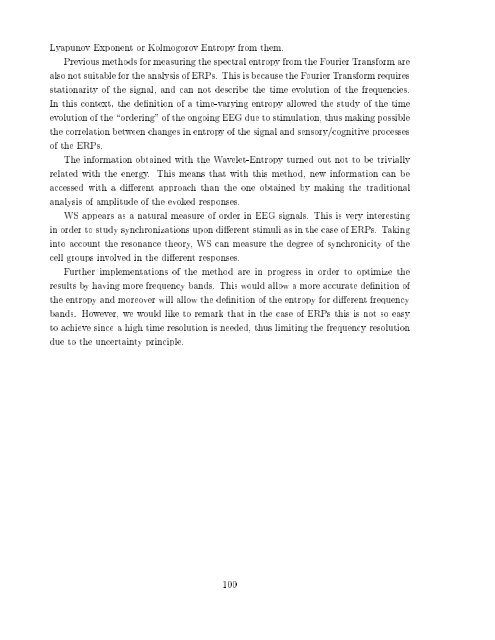Quantitative analysis of EEG signals: Time-frequency methods and ...
Quantitative analysis of EEG signals: Time-frequency methods and ...
Quantitative analysis of EEG signals: Time-frequency methods and ...
Create successful ePaper yourself
Turn your PDF publications into a flip-book with our unique Google optimized e-Paper software.
Lyapunov Exponent or Kolmogorov Entropy from them.<br />
Previous <strong>methods</strong> for measuring the spectral entropy from the Fourier Transform are<br />
also not suitable for the <strong>analysis</strong> <strong>of</strong> ERPs. This is because the Fourier Transform requires<br />
stationarity <strong>of</strong> the signal, <strong>and</strong> can not describe the time evolution <strong>of</strong> the frequencies.<br />
In this context, the denition <strong>of</strong> a time-varying entropy allowed the study <strong>of</strong> the time<br />
evolution <strong>of</strong> the \ordering" <strong>of</strong> the ongoing <strong>EEG</strong> due to stimulation, thus making possible<br />
the correlation between changes in entropy <strong>of</strong> the signal <strong>and</strong> sensory/cognitive processes<br />
<strong>of</strong> the ERPs.<br />
The information obtained with the Wavelet-Entropy turned out not to be trivially<br />
related with the energy. This means that with this method, new information can be<br />
accessed with a dierent approach than the one obtained by making the traditional<br />
<strong>analysis</strong> <strong>of</strong> amplitude <strong>of</strong> the evoked responses.<br />
WS appears as a natural measure <strong>of</strong> order in <strong>EEG</strong> <strong>signals</strong>. This is very interesting<br />
in order to study synchronizations upon dierent stimuli as in the case <strong>of</strong> ERPs. Taking<br />
into account the resonance theory, WS can measure the degree <strong>of</strong> synchronicity <strong>of</strong> the<br />
cell groups involved in the dierent responses.<br />
Further implementations <strong>of</strong> the method are in progress in order to optimize the<br />
results by having more <strong>frequency</strong> b<strong>and</strong>s. This would allow a more accurate denition <strong>of</strong><br />
the entropy <strong>and</strong> moreover will allow the denition <strong>of</strong> the entropy for dierent <strong>frequency</strong><br />
b<strong>and</strong>s. However, we would like to remark that in the case <strong>of</strong> ERPs this is not so easy<br />
to achieve since a high time resolution is needed, thus limiting the <strong>frequency</strong> resolution<br />
due to the uncertainty principle.<br />
100




